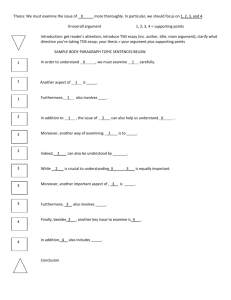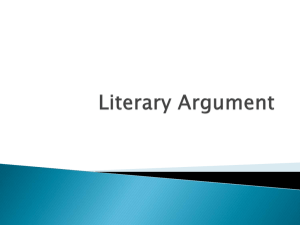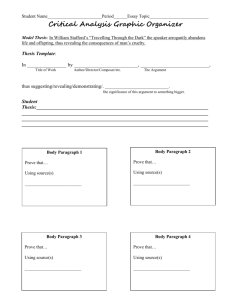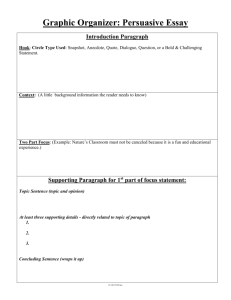Writing Refutation Paragraphs: Guide & Examples
advertisement
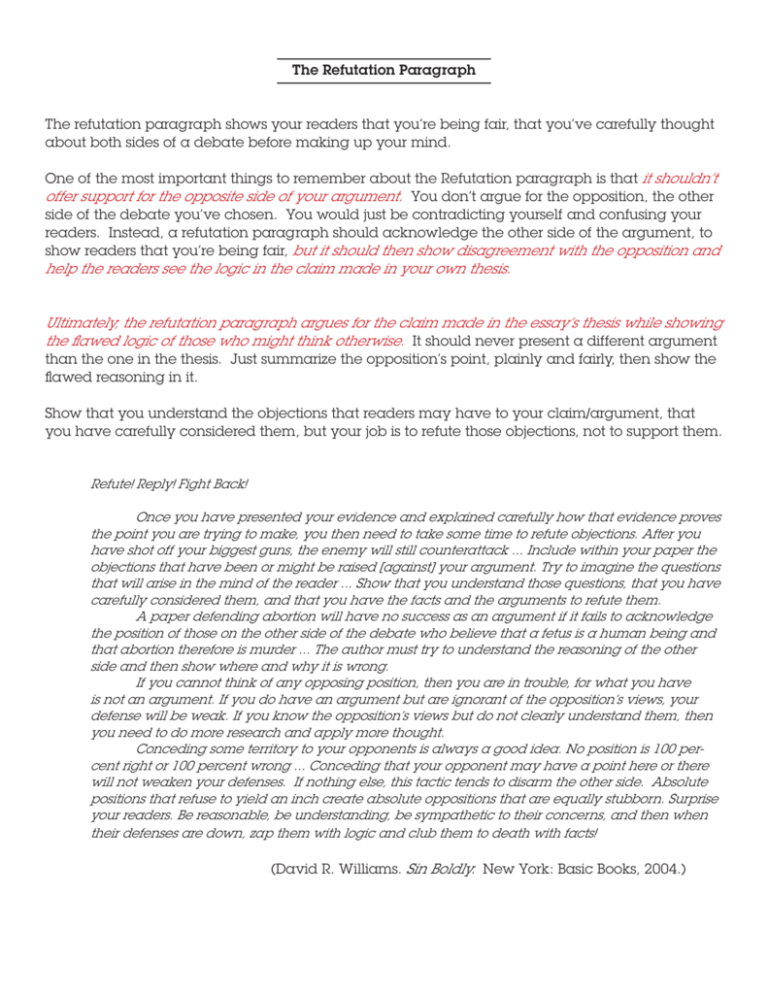
The Refutation Paragraph The refutation paragraph shows your readers that you’re being fair, that you’ve carefully thought about both sides of a debate before making up your mind. One of the most important things to remember about the Refutation paragraph is that it shouldn’t offer support for the opposite side of your argument. You don’t argue for the opposition, the other side of the debate you’ve chosen. You would just be contradicting yourself and confusing your readers. Instead, a refutation paragraph should acknowledge the other side of the argument, to show readers that you’re being fair, but it should then show disagreement with the opposition and help the readers see the logic in the claim made in your own thesis. Ultimately, the refutation paragraph argues for the claim made in the essay’s thesis while showing the flawed logic of those who might think otherwise. It should never present a different argument than the one in the thesis. Just summarize the opposition’s point, plainly and fairly, then show the flawed reasoning in it. Show that you understand the objections that readers may have to your claim/argument, that you have carefully considered them, but your job is to refute those objections, not to support them. Refute! Reply! Fight Back! Once you have presented your evidence and explained carefully how that evidence proves the point you are trying to make, you then need to take some time to refute objections. After you have shot off your biggest guns, the enemy will still counterattack ... Include within your paper the objections that have been or might be raised [against] your argument. Try to imagine the questions that will arise in the mind of the reader ... Show that you understand those questions, that you have carefully considered them, and that you have the facts and the arguments to refute them. A paper defending abortion will have no success as an argument if it fails to acknowledge the position of those on the other side of the debate who believe that a fetus is a human being and that abortion therefore is murder ... The author must try to understand the reasoning of the other side and then show where and why it is wrong. If you cannot think of any opposing position, then you are in trouble, for what you have is not an argument. If you do have an argument but are ignorant of the opposition’s views, your defense will be weak. If you know the opposition’s views but do not clearly understand them, then you need to do more research and apply more thought. Conceding some territory to your opponents is always a good idea. No position is 100 percent right or 100 percent wrong ... Conceding that your opponent may have a point here or there will not weaken your defenses. If nothing else, this tactic tends to disarm the other side. Absolute positions that refuse to yield an inch create absolute oppositions that are equally stubborn. Surprise your readers. Be reasonable, be understanding, be sympathetic to their concerns, and then when their defenses are down, zap them with logic and club them to death with facts! (David R. Williams. Sin Boldly. New York: Basic Books, 2004.) Here is an example of a refutation paragraph for different theories of teaching writing: George Will’s editorial in Newsweek states that the reason “Johnny Can’t Write” is the misguided nature of English teachers who focus more on issues of multiculturalism, political correctness, new theories of reading such as deconstruction, and so on, than on the hard and fast rules for paragraph development, grammar, and sentence structure. [concise yet fair summary of opposition’s argument] Although Will interviews students and uses sample course descriptions to back up his opinion, he misses the main point: all the “fashionable” theories and approaches he decries have actually been proven to teach writing more effectively than the traditional methods he favors. [refutation that will develop why Will’s judgment is wrong] (http://writing.colostate.edu/guides/documents/argueparts/refuting.cfm) Here is another example of a refutation paragraph for classifying men and women as certain “types”: Thesis: “Not all women are emotional thinkers, and not all men are analytical thinkers.” Antithesis (anti-thesis): “All women are emotional thinkers.” Refutation paragraph: Sure, I can admit that in certain cases women can be more emotional thinkers who look at “big picture” concepts, and, yes, men can be more item-by-item analyzers whose strengths lie in focusing on one thing at a time, but that isn’t always the case. That kind of thinking is oversimplifying the human existence. It prescribes general classifications to complex creatures like human beings in such simplistic terms. We are more complicated than that. We are so wonderfully diverse as a people that it puts a pallor on our existence in this world, and I would rather choose to seek out and celebrate the variances in our existence rather than be limited by the sameness of it. Condescending and/or alienating your audience -- avoid this sort of writing: It is small minded-and petty to think this way. You’re just not that smart if you think that all women are only one type of way and that all men are another type.


